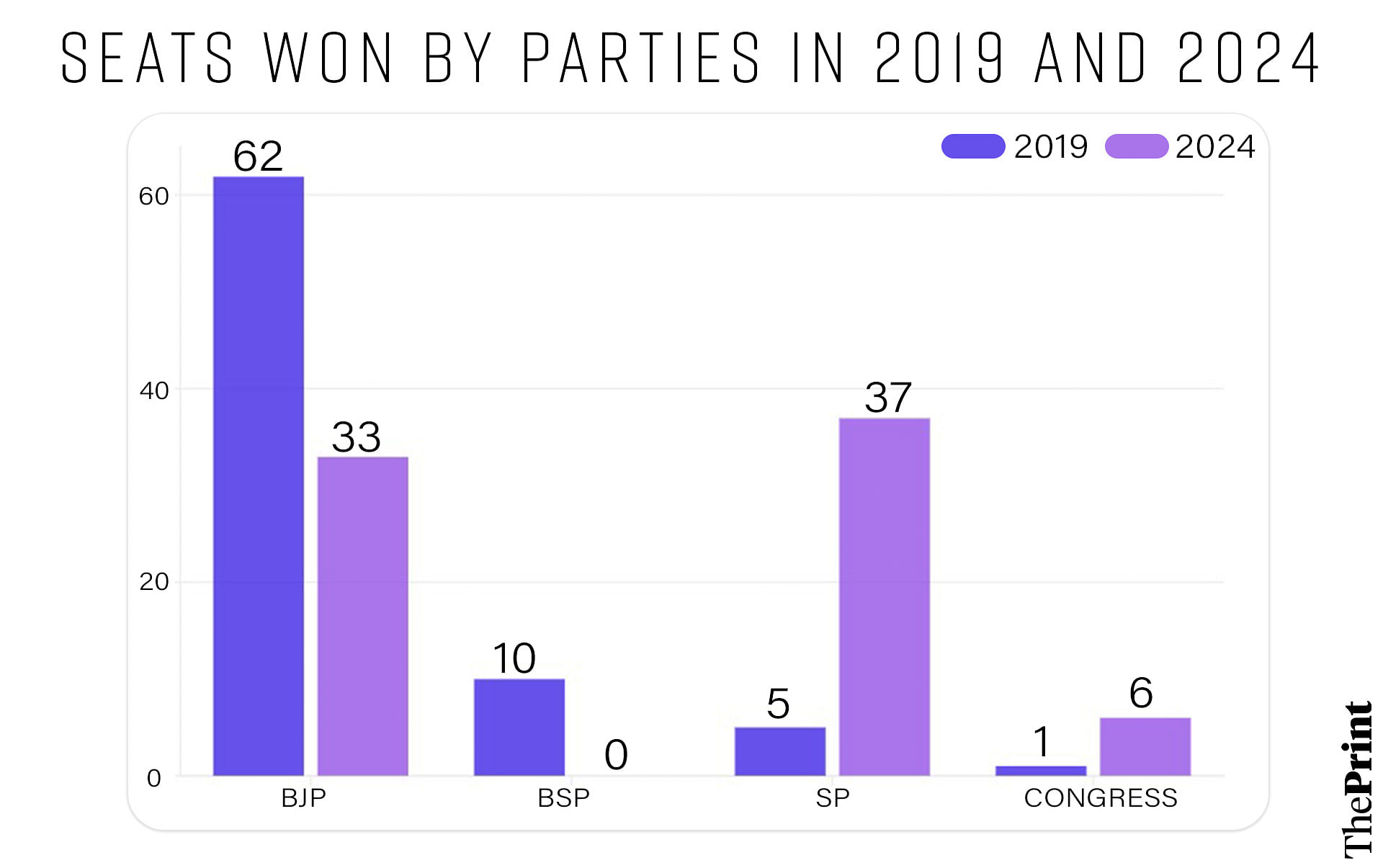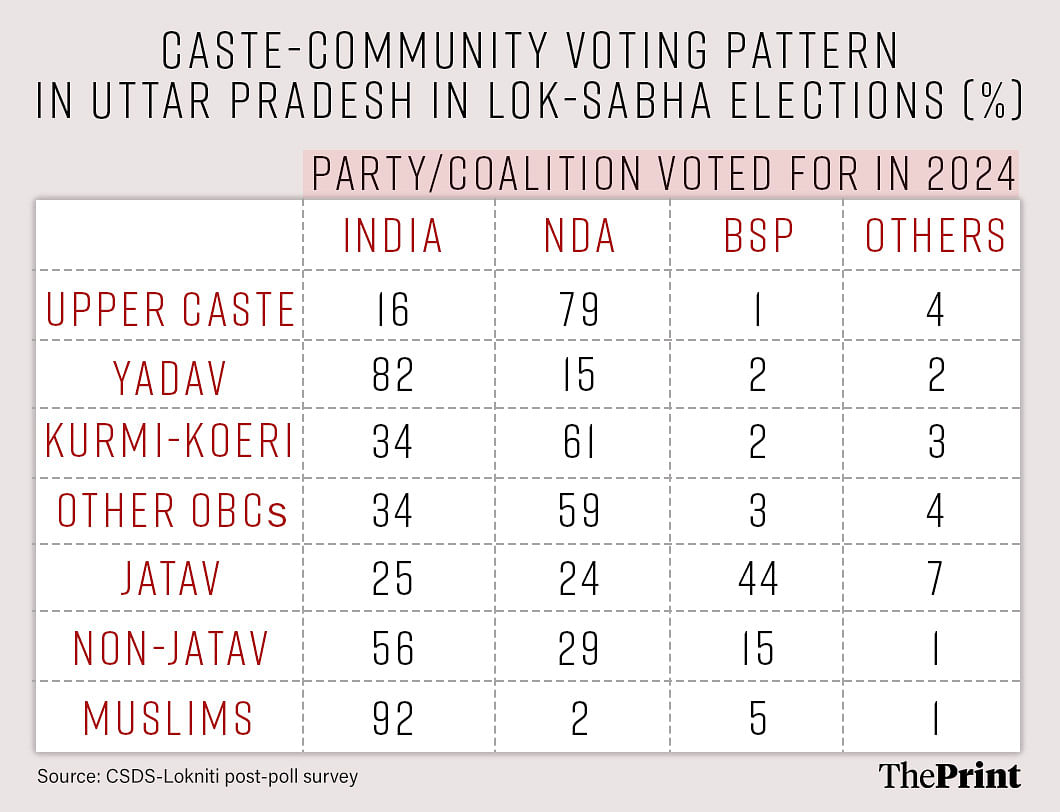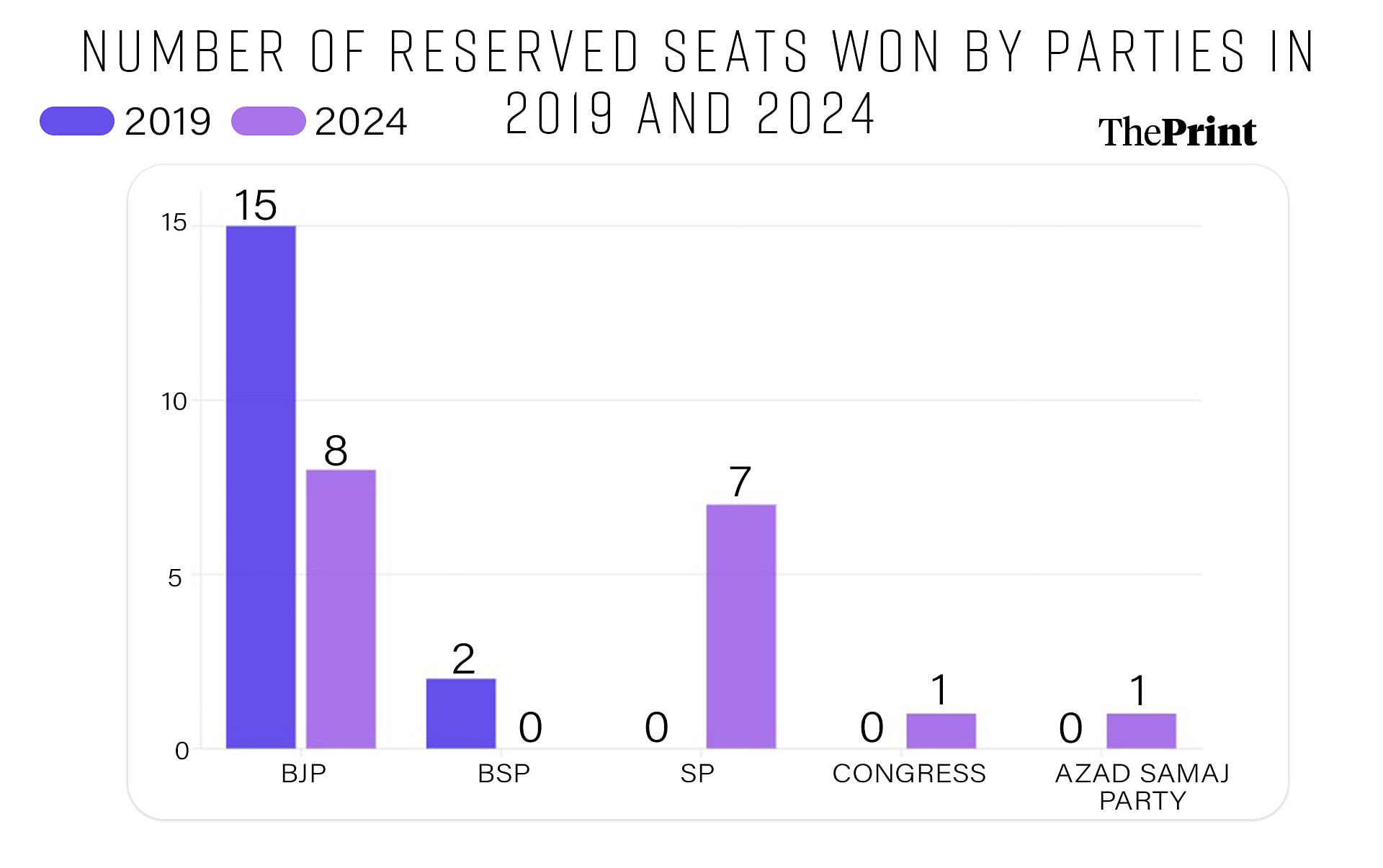
According to a post-poll survey conducted by the Centre for the Study of Developing Societies (CSDS)-Lokniti, published in The Hindu, the SP’s performance in this election — jumping to 37 seats from just five in 2019 — was the result of a consolidation of Yadav and Muslim voters, along with a sizeable share of non-Jatav Dalits.
The data shows that 92 percent of Muslims and 82 percent of Yadavs voted for the INDIA bloc. However, in addition, the alliance gained significantly by winning 56 percent of the non-Jatav Dalit vote as well. In addition, 25 percent of Jatav Dalits, too, voted for the alliance.
In comparison, the BJP, which over the years has sought to carve out a constituency among non-Jatav Dalits, suffered a reversal this time. The BJP-led NDA managed to get only 29 percent of the non-Jatav Dalit vote, a steep decline from the 48 percent it had won in 2019.
However, the NDA did improve its vote share among Jatavs since the last Lok Sabha elections. In 2019, it had won just 17 percent of the Jatav vote, while in 2024, its vote share increased to 24 percent.

The BSP saw its vote share reduced to single digits for the first time in decades. It won just 9 percent of the vote in 2024, down from 13 percent in UP’s last assembly elections in 2022 and 19 percent in the last Lok Sabha elections, which it fought in alliance with the SP. This time, the party was able to retain just 44 percent of the Jatav vote, its traditional voter base.
Moreover, just 15 percent of non-Jatav Dalits voted for the BSP. While the non-Jatav Dalit vote has been steadily moving away from the BSP over the past decade, at least, until this election, it was the BJP that had been gaining this vote.
However, in 2024, the SP-Congress alliance, too, gained from the shrinking presence of the BSP.
Also read: 0 Lok Sabha seats, dipping vote share, no second-rung leadership — BSP faces existential crisis
Candidate selection by SP, BSP’s perennial decline
The results seem to show that SP chief Akhilesh Yadav’s attempt to stitch together a Pichde-Dalit-Alpsankhyak (PDA) or Backward-Dalit-Minority alliance worked on the ground. While the party has traditionally had a Muslim-Yadav voter base, this time the SP attempted to broaden its base by giving tickets to 32 OBCs (of whom only five were Yadavs), 16 Dalits, 10 upper-caste candidates, and four Muslims.
In the 17 reserved constituencies in UP, the SP’s tally went up from zero in the last election to seven in this election. Meanwhile the BSP and the BJP’s tallies fell from 2 and 15 in 2019 to zero and eight, respectively. The Congress and Chandrashekhar Azad’s Azad Samaj Party won one seat each in the reserved constituencies.
However, the SP even fielded Dalit candidates in non-reserved seats such as Faizabad and Meerut. Its Dalit candidate, Awadhesh Prasad, managed to defeat the BJP’s Lallu Singh by a margin of over 50,000 votes in Ayodhya just months after the consecration of the Ram Temple.

One of the major factors that enabled the INDIA bloc to significantly improve its vote share among Dalits is the gradual, but definitive, decline of the BSP over the past decade, which has ensured that the Dalit vote has been up for grabs in UP.
In the 2019 election, the BSP was able to secure 19 percent of the vote share in UP and win 10 seats in the Lok Sabha as it piggybacked on the SP’s support base. However, since 2012, its vote share has shrunk considerably with each passing election.
In the 2007 assembly election in UP, the BSP was voted to power with a single-party majority for the first time, winning 206 of the 403 assembly seats, and securing a vote share of around 30 percent.
In the 2012 assembly elections, its tally dropped to 80 seats, while its vote share dipped to 26 percent. In 2017, the party managed to secure only 19 seats, even as its vote share dipped only marginally to around 22 percent.
In the 2022 assembly elections came the BSP’s worst-ever performance till then, as it managed to win only one seat, and its vote share dipped to around 13 percent.
“In this election particularly, Mayawati’s strategy puzzled the Jatavs,” argues A.K. Verma, director of the Centre for the Study of Society and Politics, a Kanpur-based think tank. “Akash Anand was getting significant traction on the ground, and suddenly without any explanation, he was removed from the position of president without any explanation…This angered the Jatavs, and there was a sudden derailment,” he says.
Mayawati had named her nephew Akash Anand her political successor last December but during the Lok Sabha election campaign, she removed him from the post of national coordinator until he “gains maturity”. This came days after Anand — who had begun to attract attention and draw crowds — was booked for violating the Model Code of Conduct by referring to the BJP-led central government as “terrorist”.
Also read: Jai Bhim or Jai Shri Ram? UP Dalits at a political crossroads post BSP decline
‘Moral panic’ over the Constitution
The second reason behind the shift in the Dalit vote towards the INDIA bloc was the pervasive fear created among Dalits by the narrative of the Constitution being under threat, says Verma.
“This fear penetrated deep into the Dalit psyche,” he says. “The 400 paar narrative created this fear among them because no rational explanation was given by the BJP to aim for 400-plus seats, and Akhilesh (Yadav) and Rahul (Gandhi) grabbed this opportunity, and effectively spread the fear that the BJP wants to demolish Babasaheb Ambedkar’s Constitution,” he adds.
Arvind Kumar, assistant professor, sociology and criminology at Royal Holloway, University of London, agrees. “There was a moral panic created among the Dalits over the threat to the Constitution,” he says.
However, he adds that even in the 2022 assembly elections, in which the SP tally improved by 64 seats from 2017, there were undercurrents of the Dalit vote moving away from the BJP and towards the SP.
“There was already a wind towards the Samajwadi Party, and the BJP did nothing to course correct,” he says. “In eastern UP, the middle class among Dalits gets created through government jobs. The BJP government’s performance on this front has created a massive sense of frustration among Dalits where they are getting no government employment, thereby thwarting their upward mobility.”
The “moral panic” created over the Constitution became the rallying point of this existing resentment, he adds.
Can the SP sustain the Dalit support?
According to Verma, however, the fear of the Constitution being changed was arguably the only reason the Dalit vote shifted to the SP this time. “The BJP has offered political accommodation, security in terms of law and order, economic security through welfare and cultural inclusion to Dalits,” he says. “They had no reason not to vote for the BJP other than the fear over the Constitution…More than a vote for the SP-Congress, it was a vote against the BJP.”
Both Verma and Kumar, however, say that the SP might find it difficult to sustain this coalition going ahead.
“They might be able to sustain this in eastern UP, where Yadavs have traditionally even been leaders of the Dalits,” says Kumar. “But in western UP, the Yadavs are zamindar-like, and there is significant local conflict between Yadavs and the Dalits there.”
Verma agrees. “Yadavs and Dalits have shared a deeply conflictual relationship, wherein Yadavs, who are the dominant agricultural communities, are seen as the social as well as economic exploiters of the Dalits, who work as labour on their lands,” he says. “Even in this election, the Dalits have voted for the SP because it is in alliance with the Congress,” he argues.
“The Constitution narrative came to be the big undoing of the BJP…Whether or not that can sustain the Dalit vote in favour of the SP is to be seen,” he says.
Also read: ‘Infighting, public anger, Lallu Singh’s slip of tongue’ — what led to BJP’s poll debacle in UP













